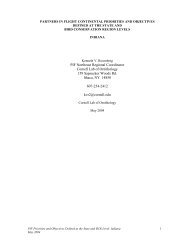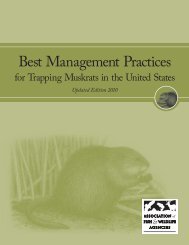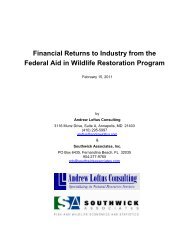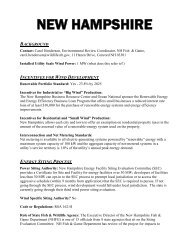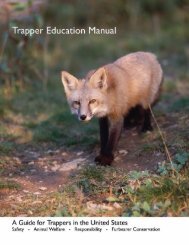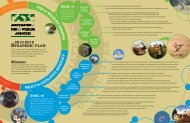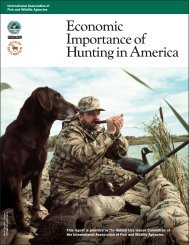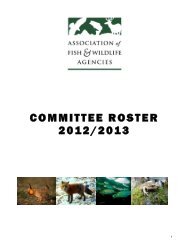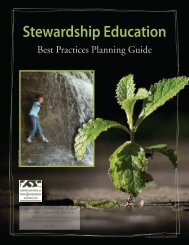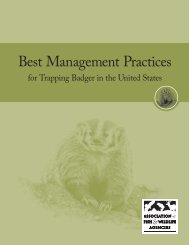Modern Snares for Capturing Mammals: - Association of Fish and ...
Modern Snares for Capturing Mammals: - Association of Fish and ...
Modern Snares for Capturing Mammals: - Association of Fish and ...
- No tags were found...
Create successful ePaper yourself
Turn your PDF publications into a flip-book with our unique Google optimized e-Paper software.
The appropriate deployment specifications (e.g., loop size, loop height, lock position, ‘loading’snares, etc) <strong>for</strong> maximizing snare efficiency are best learned through snaring “How To” books<strong>and</strong> field experience. With respect to mechanical attributes that influence efficiency, one shouldfocus on three issues: 1) particularly when live-restraining animals, use designs that minimize thechance the desired animal will break or bite through the cable; 2) use designs that facilitatesmooth rapid closure when activated by the desired animal; <strong>and</strong> 3) when incorporating devices toimprove selectivity, consider potential trade<strong>of</strong>fs with efficiency. In some cases, there may belittle trade<strong>of</strong>f (i.e., there will be little loss <strong>of</strong> efficiency). In cases where a selectivity feature doesreduce efficiency, the acceptable level <strong>of</strong> trade<strong>of</strong>f may be influenced by factors such as whetheranimals unintentionally captured can be released alive, <strong>and</strong> the legal or biological ‘status’ <strong>of</strong>those animals.CONCLUSIONS<strong>Snares</strong> represent one <strong>of</strong> the oldest <strong>for</strong>ms <strong>of</strong> animal capture devices, <strong>and</strong> the principles <strong>of</strong> snaredeployment have not changed substantially. However, the mechanical attributes <strong>and</strong> options <strong>for</strong>snares have changed significantly in recent years, <strong>and</strong> will likely continue to exp<strong>and</strong>.Un<strong>for</strong>tunately, the public, many resource pr<strong>of</strong>essionals, <strong>and</strong> some trappers are not familiar withall the features <strong>and</strong> variations <strong>of</strong> modern snares. Various snare designs have been used tocapture wildlife species <strong>for</strong> reintroductions or research, including such species as bears, wolves,lynx, fox, coyote, <strong>and</strong> beaver. As with any capture device, achieving the desired per<strong>for</strong>mancerequires both experience <strong>and</strong> an underst<strong>and</strong>ing <strong>of</strong> mechanical attributes <strong>and</strong> options.While much is known about whether specific snare features can influence a given per<strong>for</strong>mancecriterion, there is a need <strong>for</strong> additional scientific data to better underst<strong>and</strong> the degree to whichthey may do so. While additional data would allow us to refine our ability to predict snareper<strong>for</strong>mance, there are likely three things that won’t change:‣ Trappers <strong>and</strong> resource pr<strong>of</strong>essionals need to consider all per<strong>for</strong>mance criteria (killingversus live-restraint, animal welfare, selectivity, <strong>and</strong> efficiency) when selecting snaredesigns. Changing design to influence one per<strong>for</strong>mance attribute may alter (positively ornegatively) other per<strong>for</strong>mance.‣ For a single per<strong>for</strong>mance criterion, biologists <strong>and</strong> trappers must consider multiplevariables when striving <strong>for</strong> a desired outcome. Ignoring one variable may yieldunintended results.‣ There are likely multiple configurations that will accomplish the same objective. When aspecific outcome is necessary or desired, biologists (<strong>and</strong> trappers) should not onlyfamiliarize themselves with any current data that exist, but should recognize wheremultiple configurations may be acceptable. Restricting to only one specific configurationmay not be necessary, <strong>and</strong> may even be counterproductive if it limits the options usershave to adapt to specific situations or locations.23Ver. 1.0



